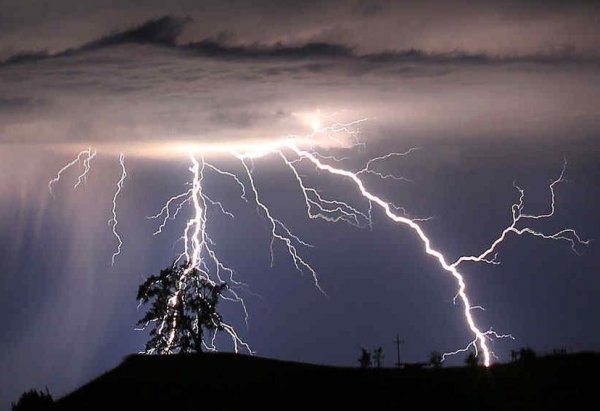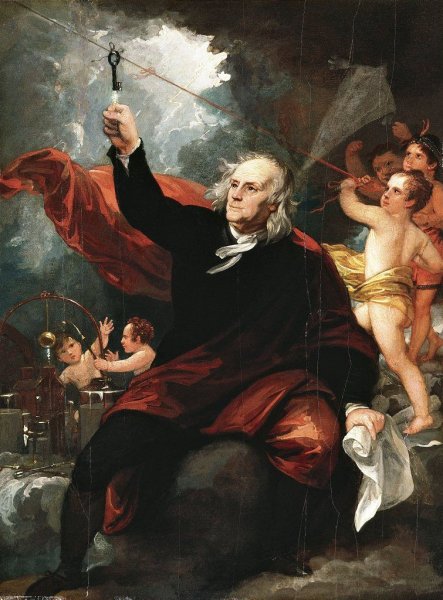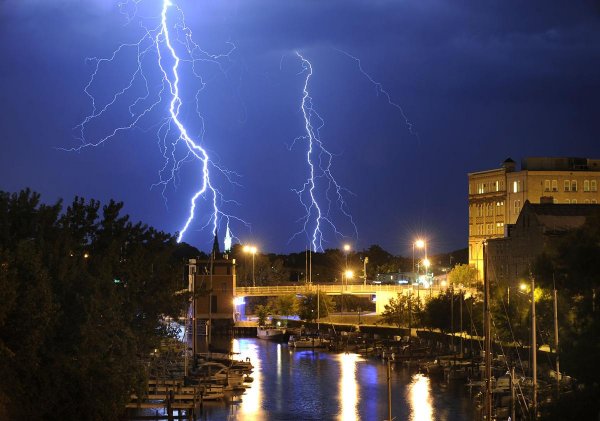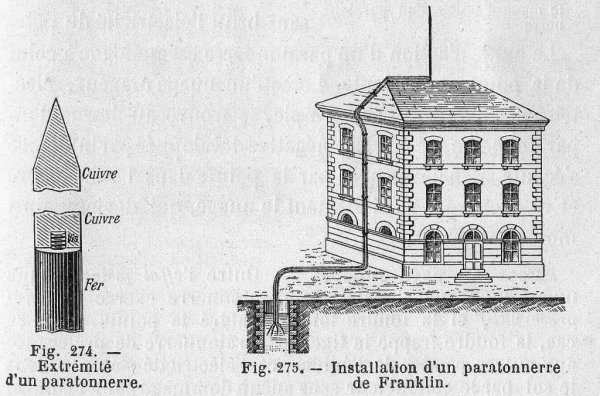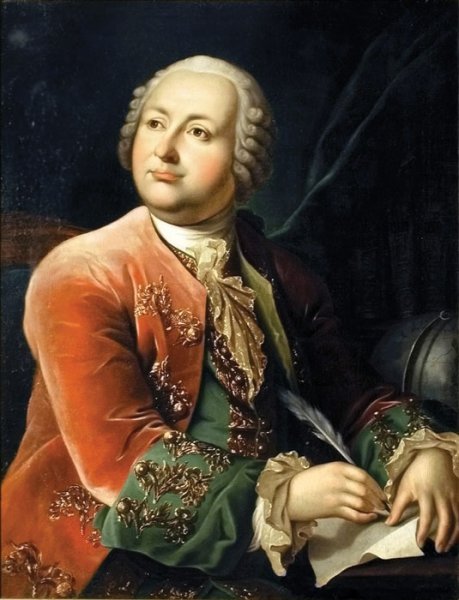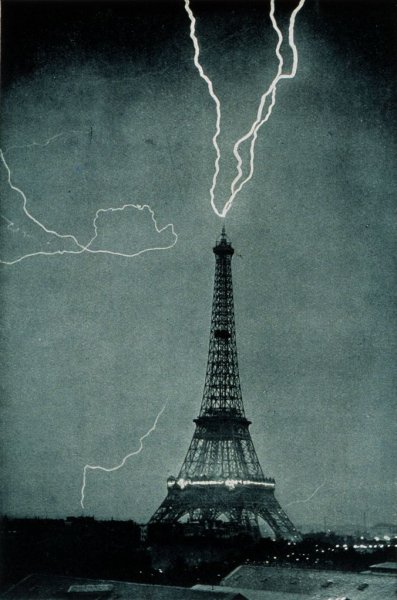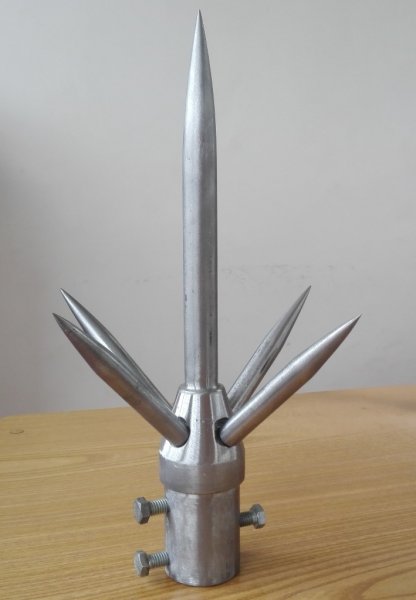The history of the creation of a lightning rod (lightning rod), the first inventions of lightning protection
The first mention of lightning in history
The fire at which man was first introduced was probably a flame arising from Lightning in wood or dry grass. Therefore, according to the legend, "the fire came from the sky." Even the most ancient nations deified lightning, then the ancient Greeks, Chinese, Egyptians, Slavs.
There is an ancient Greek myth about the titan Prometheus, who stole fire from the gods and gave it to humans.
A biblical legend told by the prophet Elijah is associated with lightning: in front of King Ahab and the priests of the god Baal on Mount Carmel "the fire of the Lord fell and burned the burnt offering, trees, stones and earth", after which a strong wind arose and a thunder storm broke out.
In China from the time of the Han era (206 BC - 220 AD) A relief depicting the god of thunder has been preserved.
Powerful thunders and blinding lightnings have caused fear in people since ancient times.For a long time, man could not explain this mysterious and terrifying phenomenon of nature, but he tried to protect himself from it.
It is known from the chronicles of the ancient Egyptians that many thousands of years ago they erected to protect the temples from lightning (to catch the "heavenly fire") metal supports with gilded tops and tall wooden masts studded with copper bands, although no one he had not the slightest idea of the nature of electricity.
These are the first lightning rods in history. They generate strong upward discharges and thus provide a safe path for lightning to land. Apparently, the knowledge of the ancient Egyptians was based on experience that was later forgotten by people.
Lightning Rod by Benjamin Franklin
Benjamin Franklin (1706 - 1790) - a famous American figure, known in the diplomatic, journalistic and scientific fields, was one of the first inventors of the lightning rod.
In 1749 he proposed that tall grounded metal masts—lightning rods—be erected near buildings from lightning. Franklin mistakenly assumed that the lightning rod would "suck" electricity out of the clouds. As early as 1747 he wrote about this property of metal points.
He was famous not only in many European cities, but also in Philadelphia. This knowledge is the result of numerous experiments with electricity since the opening of the Leyden jar in 1745.
Franklin's idea of a lightning rod was stated in a letter from Philadelphia, dated August 29, 1750, to P. Collinson. Franklin wrote of two types of lightning rods—a simple rod-shaped, pointed lightning rod with grounding, and a downstream device that is "divided into a greater number of points." Information about the type of lightning rod has become widespread.
On September 9, 1752In the Pennsylvania Gazette, Franklin published a brief report that several Parisian noblemen had placed metal poles on their roofs to protect them from lightning.
On October 1, 1752, Franklin wrote to Collinson that he himself had installed two lightning rods on public buildings in Philadelphia.
It is likely at this time that he installed a grounded experimental device in his house for the study of atmospheric electricity, which could objectively serve as a lightning rod.
When Benjamin Franklin invented a lightning rod (often called a lightning rod), many did not believe. Is it possible for a person to obstruct God's providence? But Franklin was going to prove it, because he himself never looked for easy ways, and lightning simply (according to his assumption) watched.
As you know, in Philadelphia Franklin published his paper, so there were often violent thunderstorms, and where there are thunderstorms, there is lightning, and where there is lightning, there are fires. And Franklin had to publish in his newspaper from time to time about the burnt ranches along with other news, and he was sick of the business.
In his youth, Franklin liked to study physics, so he was absolutely sure of the electrical origin of lightning. Knowing Benjamin and the fact that the electrical conductivity of iron is much higher than that of tiles. So, according to the theory of finding easy ways, which Benjamin knew very well, the atmospheric charge would rather hit a metal pole than the roof of a house. All that remained was to convince the incredulous residents of Philadelphia and lightning.
Once, on one of the cloudy days in 1752, Benjamin Franklin went out into the street, in his hands was not an umbrella, but a kite.
In front of an astonished audience, Franklin moistened the rope with brine, tied the end of it to a metal key, and released the kite into the stormy sky.
The snake was understood and almost out of sight, when suddenly there was a flash of lightning and a deafening crack, and at the same moment a ball of fire rolled down the rope, the key in Franklin's hands began to pour out sparks. It has been proven that lightning can be tamed.
Franklin, using his influence in scientific circles, began to widely promote his lightning rod. Soon a long metal pole dug into the ground next to the house became commonplace. First in Philadelphia, then all over America and only later in Europe. But there were those who resisted and placed poles not outside but inside the house, but for obvious reasons they are becoming fewer and fewer.
Lightning rod MV Lomonosov
M. V. Lomonosov (1711 — 1765) — the great Russian naturalist, philosopher, poet, member of the St. Petersburg Academy of Sciences, founder of Moscow University, invented the lightning rod independently of B. Franklin.
In 1753, in his essay "A word on aerial phenomena of electrical origin," he expressed the correct idea of the action of a lightning rod and the discharge of a lightning rod with its help into the ground, which corresponds to modern views. He studied thunderstorm phenomena in the natural conditions of St. Petersburg together with Academician G. V. Richman, for this purpose he designed several devices.
On July 26, 1753, while conducting experiments with atmospheric electricity, Academician Richman was killed by lightning.
In the same year, Lomonosov proposed that lightning rods be erected in the form of high pointed iron rods to protect buildings from lightning, the lower end of which would go deep into the ground.The first lightning rods began to be installed in various cities of Russia in accordance with his recommendations.
Lightning strikes the Eiffel Tower in the early 20th century — believed to be the first photograph of lightning in history
Types of the first lightning rods
To this day, a lightning rod is used to protect against lightning. The impetus for the mass construction of lightning rods was the disaster in the Italian city of Brescia, where in 1769 lightning struck a military warehouse. The explosion destroyed one-sixth of the city, killing about 3,000 people.
Franklin Lightning Rod it originally consisted of a single, pointed bar mounted on the ridge of the roof, and a ground branch drawn along the surface of the roof, in the middle of it (now only occasionally used).
Gay-Lussac lightning rod consists of several interconnected traps and outlets, mainly in the corners of the building.
Lightning rod Findeisen— high traps are not used in this design. All larger metal objects on roofs are connected to the turns. This is currently the most recommended method of lightning protection for conventional buildings.
Chamber lightning rod (Faraday chamber) forms a network of wires over the protected object.
Lightning rod mast (also called vertical) is a mast installed near the protected object, but not connected to it.
Radioactive lightning rod— uses radioactive salts in traps, contributing to the ionization of the atmosphere and to some extent increasing the effectiveness of the lightning rod. The radioactive lightning rod is built on the principle of the ionization "cone", the resistance of which is less than that of the surrounding air. Such a lightning rod protects an area within a radius of 500 m from lightning. A few such lightning rods are enough to protect an entire city.
Important moments
Currently, lightning rods are installed at the highest possible points to shorten the lightning path and protect the largest space.
Modern lightning rods are characterized by a more efficient, simple and rational design compared to lightning rods of an older generation.
The three main parts of a lightning rod are: lightning arrester, conductor and ground. Most modern lightning rods differ only in the design of the uppermost part, i.e. Taps and grounding for all types of lightning rods are the same and the same requirements apply to them.
Reliable protection against destructive lightning strikes is a technically sound lightning rod, installed by a specialist and in the correct order.
In good condition, lightning rods guarantee the highest degree of protection that modern technologies can provide, in exceptional cases — lightning with high parameters can also damage protected buildings.
When installing a lightning rod, you should consider the following: lightning strikes not only tall buildings, but also low ones. Branch discharge can hit several buildings at the same time.
A poorly designed or damaged lightning rod is more dangerous than none at all.
Do you know this?

